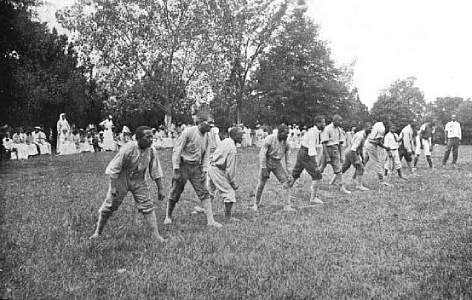
 Residents of Central State Hospital playing Field Sports in 1910, Asylum projects.
Residents of Central State Hospital playing Field Sports in 1910, Asylum projects.
New categories in the classification of causes of insanity emerged in asylums in the United States after the 1870s. These were shaped by recent political events that had reformed the social, political and moral order of the country, especially the Civil War and the victory of the Union over the Confederate States in 1865.
During the Reconstruction (1865-1877), then the Segregation imposed by Jim Crow laws (1877-1965) in the former slave states, the newly freed underwent special classifications when they were interned in institutions. Between 1877 and 1898, the all-white administrators of the Central Lunatic Asylum for Colored Insane in Virginia routinely used the categories of “political excitement” or “sudden emancipation” to qualify the madness of black patients who were deemed unfit to exercise their freedom. Medical professors at Tulane University, such as Joseph Jones, also used this classification of “political excitement” at the same time in another southern state, Louisiana; it was defined by Louisianan physicians as the result of “several changes in political and racial states, such as those brought about by the Great Civil War of 1861-65” among former slaves. These political changes (the emancipation of slaves, the triumph of anti-slavery) were seen as throwing these freedmen into a state of madness called «demonic». Doctors such as Joseph Jones, who was a staunch anti-abolitionist, saw the exercise of civil rights for Black people as a motive for mental disturbance for the latter: by using this classification among his Black patients, it pathologized their possibilities of political and social emancipation, using medicine as a tool in the service of white political power.
These categorizations, which were circulating in several southern states such as Virginia and Louisiana, highlight the racialized social and political control mechanism that was deployed within psychiatric institutions. They also reveal that, after the Civil War, doctors were introducing differential treatment of populations according to their race.
On the other hand, the “political excitement” echoes the diseases of black slaves described by Samuel Cartwright some 30 years earlier, in a socio-historical and political context, however, quite different from slavery. In contrast to Cartwright’s theoretical concepts such as “drapetomania” published in medical journals that were not applied to asylum routines, references to “political excitement” or “sudden emancipation” as causes of insanity show that the black population was subjected to a pathologization of its civil rights within the asylum itself. The shaping of these two categories is contemporary with the resentment that the southern elites held towards the soldiers of the Union and the armed conflict that had destroyed their economic and political slave system. As historian George Frederickson reveals, by the end of the war, the southern white political elite was fuelling intense hatred of the Black population, while federal troops were spread over the territories of the former Confederation. Moreover, after 1877, numerous segregationist laws were introduced by the political elite of the South after Reconstruction (1865-1877) when the Blacks had been able to obtain civil rights after the ratification of the 13th, 14th and 15th amendments to the Constitution.
These classifications, which were used after 1877, were undoubtedly involved in restricting the civil rights of the freed population in the context of the gradual establishment of racial segregation in the southern states. This social and political climate helped to shape the classifications of mental pathologies developed by white doctors, who were involved in large numbers in the local political life of their former confederate states.
Read more in the dictionary : Nostalgia - Drapetomania
Read the paper in French : Excitation politique
References :
Élodie Grossi, « Bad Brains » : Race et Psychiatrie de la fin de l’esclavage à l’époque contemporaine aux États-Unis, thèse de doctorat de sociologie soutenue à l’université Paris Diderot en novembre 2018.
Christopher Willoughby, “Running Away from Drapetomania : Samuel Cartwright and Racial Medicine in the Antebellum South”, Journal of Southern History, vol. 84, n° 3, août 2018, p. 579-614.
To quote this paper : Elodie Grossi, "Political excitement" in Hervé Guillemain (dir.), DicoPolHiS, Le Mans Université, 2020.